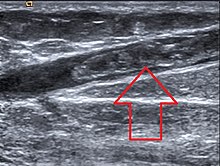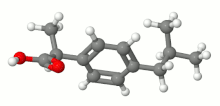Thrombophlebitis
| Thrombophlebitis | |
|---|---|
| Other names | Phlebitis[1] |
 | |
| Ultrasonographic image showing thrombosis of the great saphenous vein. | |
| Specialty | Cardiology |
| Symptoms | Skin redness[1] |
| Risk factors | Smoking, Lupus[1] |
| Diagnostic method | Doppler ultrasound, Venography[1] |
| Treatment | Blood thinners, Pain medication[1] |
Thrombophlebitis is a
Signs and symptoms
The following symptoms or signs are often associated with thrombophlebitis, although thrombophlebitis is not restricted to the veins of the
- Pain (area affected)
- Skin redness/inflammation
- Edema
- Veins hard and cord-like
- Tenderness
Complications
In terms of complications, one of the most serious occurs when the superficial blood clot is associated with a
Causes

Thrombophlebitis causes include disorders related to increased tendency for
Specific disorders associated with thrombophlebitis include superficial thrombophlebitis which affects veins near the skin surface, deep vein thrombosis which affects deeper veins, and pulmonary embolism.[7]
Those with familial clotting disorders such as protein S deficiency, protein C deficiency, or factor V Leiden are also at increased risk of thrombophlebitis. Thrombophlebitis can be found in people with vasculitis including Behçet's disease. Thrombophlebitis migrans can be a sign of malignancy – Trousseau sign of malignancy.[8]
Diagnosis
The diagnosis for thrombophlebitis is primarily based on the appearance of the affected area. Frequent checks of the pulse, blood pressure, and temperature may be required. If the cause is not readily identifiable, tests may be performed to determine the cause, including the following:[1][4]
- Doppler ultrasound
- Extremity arteriography
- Blood clotting tests)
Prevention
Prevention consists of walking, drinking fluids and if currently hospitalized, changing of
Treatment

In terms of treatment for this condition the individual may be advised to do the following: raise the affected area to decrease
Epidemiology
Thrombophlebitis occurs almost equally between women and men, though males do have a slightly higher possibility. The average age of developing thrombophlebitis, based on analyzed incidents, is 54 for men and 58 for women.[5]
See also
References
- ^ a b c d e f g h i j "Thrombophlebitis: MedlinePlus Medical Encyclopedia". medlineplus.gov. Retrieved 23 September 2016.
- PMID 16868304.
- PMID 31613482.
- ^ a b c d "Thrombophlebitis Clinical Presentation: History, Physical Examination, Causes". emedicine.medscape.com. Retrieved 23 October 2016.
- ^ ISBN 9780128012383. Retrieved 2 January 2021.
- PMID 17351849.
- ^ "Superficial Thrombophlebitis: Background, Pathophysiology, Etiology". eMedicine. Medscape. 12 July 2016. Retrieved 23 October 2016.
- PMID 17496204.
- ISBN 9780803657915. Retrieved 23 October 2016.
Further reading
- Sadick, Neil S.; Khilnani, Neil; Morrison, Nick (2012). Practical Approach to the Management and Treatment of Venous Disorders. Springer Science & Business Media. ISBN 9781447128915. Retrieved 23 October 2016.
- Mulholland, Michael W.; Lillemoe, Keith D.; Doherty, Gerard M.; Maier, Ronald V.; Simeone, Diane M.; Upchurch, Gilbert R. (2012). Greenfield's Surgery: Scientific Principles & Practice. Lippincott Williams & Wilkins. ISBN 9781451152920. Retrieved 23 October 2016.
